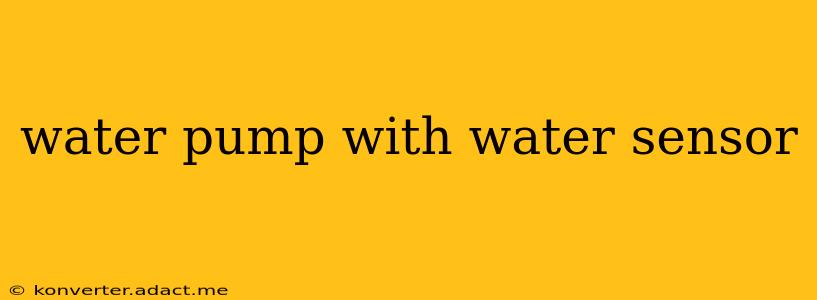A water pump with a water sensor is a smart and efficient solution for various applications, from automated irrigation systems to water level monitoring in tanks. This combination offers precise control and prevents issues like pump burnout from running dry or overflow from overfilling. This comprehensive guide explores the functionality, benefits, different types, and applications of water pumps equipped with water sensors.
What is a Water Pump with a Water Sensor?
A water pump with a water sensor is a system where a water level sensor is integrated with a pump to automate the pumping process. The sensor monitors the water level and sends signals to the pump to turn on when the level drops below a certain point and turn off when it reaches a predetermined level. This eliminates the need for manual intervention and ensures optimal water management.
How Does a Water Pump with a Water Sensor Work?
The system typically works through a simple yet effective mechanism:
-
Water Level Detection: The water sensor continuously monitors the water level within a tank, reservoir, or other water source. Different sensor types use various methods for detection (discussed below).
-
Signal Transmission: Once the water level reaches a pre-set low threshold, the sensor transmits a signal to the pump's control unit.
-
Pump Activation: The control unit receives the signal and activates the pump, initiating the pumping process to refill the water source.
-
Pump Deactivation: When the water level reaches a pre-set high threshold, the sensor sends another signal to the control unit, which deactivates the pump, preventing overflow.
Different Types of Water Sensors Used with Pumps
Several types of water sensors can be paired with water pumps:
-
Float Switches: These are the simplest and most common type. A buoyant float rises and falls with the water level, activating or deactivating a switch. They are relatively inexpensive but less precise than other options.
-
Pressure Sensors: These measure the hydrostatic pressure at the bottom of the tank, which is directly proportional to the water level. They offer better accuracy than float switches, especially in situations with fluctuating water levels.
-
Ultrasonic Sensors: These use ultrasonic waves to measure the distance to the water surface. They are non-contact sensors, meaning they don't require immersion in the water, making them ideal for applications where submersion isn't practical. They’re usually more expensive than float switches or pressure sensors.
-
Capacitive Sensors: These measure the change in capacitance as the water level changes. They're often used in smaller applications and are relatively inexpensive and reliable.
What are the Benefits of Using a Water Pump with a Water Sensor?
Several key advantages come with using a water pump integrated with a water sensor:
- Automation: Eliminates the need for manual monitoring and control, saving time and effort.
- Efficiency: Prevents pump burnout by ensuring it doesn't run dry and avoids overfilling.
- Water Conservation: Precisely manages water levels, minimizing waste.
- Improved Reliability: Consistent and reliable operation compared to manual systems.
- Reduced Maintenance: Less wear and tear on the pump due to efficient operation.
What are the Common Applications of Water Pumps with Water Sensors?
Water pumps equipped with water sensors find utility in diverse applications:
- Irrigation Systems: Automated watering of gardens, lawns, and agricultural fields, ensuring optimal water usage.
- Water Towers and Reservoirs: Maintaining consistent water levels in large-scale storage facilities.
- Aquariums and Ponds: Maintaining appropriate water levels in aquatic environments.
- Industrial Processes: Controlling water levels in various industrial processes requiring precise water management.
- Emergency Water Systems: Ensuring a reliable water supply during emergencies.
What are the factors to consider when choosing a water pump with a water sensor?
Selecting the appropriate system requires considering several factors:
- Water Source: The type and volume of water source will influence the pump's capacity and the sensor's design.
- Pump Capacity: The pump's flow rate and pressure must meet the application's demands.
- Sensor Type: Choose a sensor type that offers the required accuracy and reliability for the specific application. Consider factors like cost, ease of installation, and maintenance requirements.
- Power Supply: Ensure compatibility with the available power supply.
- Environmental Conditions: The sensor's suitability for the specific environmental conditions (temperature, pressure, etc.) should be considered.
How to install a water pump with a water sensor?
Installation procedures vary depending on the specific system and application. Always consult the manufacturer's instructions for detailed guidance. Generally, installation involves connecting the sensor to the control unit and the pump to the power source, following the wiring diagrams provided. Ensure proper placement of the sensor to ensure accurate readings.
Troubleshooting a Water Pump with a Water Sensor
If the system malfunctions, troubleshooting steps may include checking power connections, sensor calibration, and inspecting the wiring for any damage. Consulting the manufacturer’s troubleshooting guide is highly recommended.
This guide provides a comprehensive overview of water pumps with water sensors. By understanding the functionality, benefits, and different types available, you can select and install the right system for your specific needs, leading to more efficient and reliable water management. Remember to always consult professional advice for complex installations or if you encounter difficulties.
